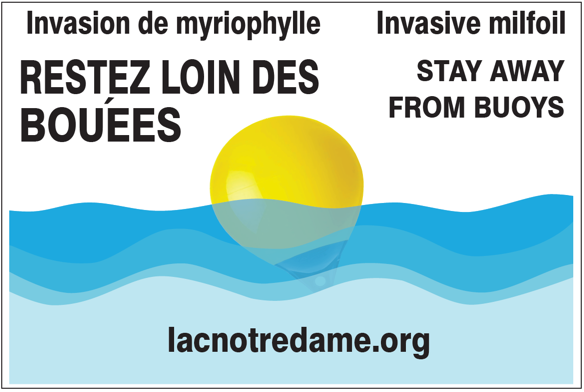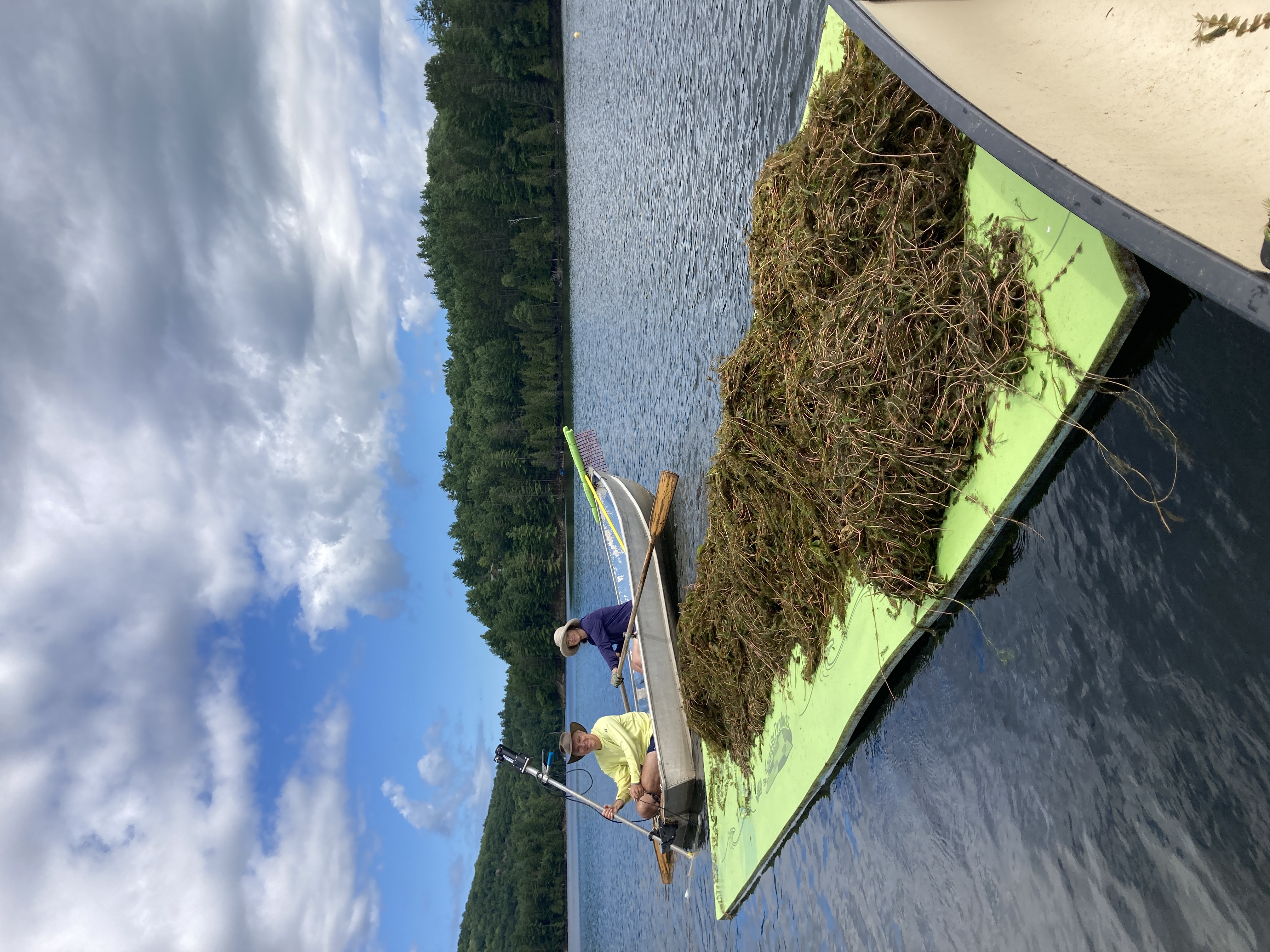Myriophylle à épis - Eurasian Milfoil in Lac Notre-Dame

Eurasian watermilfoil is an invasive aquatic plant that usually grows at depths of 1 to 4 metres and can form a dense carpet on the lake’s surface. It has been present in Lac Notre Dame since 1999.
- A zombie weed: each broken-off bit of weed can turn into a new plant.
- Boats and wind cause breakage and spread.
Le myriophylle à épis est une plante aquatique envahissante qui pousse généralement à des profondeurs de 1 à 4 mètres et peut former un tapis dense à la surface du lac.
- Une mauvaise herbe zombie : chaque morceau cassé peut se transformer en une nouvelle plante.
- Les bateaux et le vent causent la rupture et la propagation.
Contrôler
Avoid areas of the lake infested with the plant. The worst mats are marked by Association buoys - all boats should stay out of those areas.
- Évitez les zones du lac infestées par la plante. Les pires tapis sont marqués par des bouées d’association lors des mauvais étés - évitez ces zones avec n’importe quel type d’embarcation.
Milfoil bits may also drift in that have been cut up by boat motors. Remove them from the lake - use them as compost far from shore.
- Les résidents du lac sont encouragés à les retirer du lac et à les utiliser comme compost loin du rivage.
In early spring, before fish spawn, you can rip out the weeds from the root. Then cover the bottom with burlap (the thickest natural jute you can find) and use rocks from the shore or bottom to hold it down. The burlap will eventually rot away. Avoid using any plastics or possibly-contaminated rocks/weights from outside the lake.
-
Le bouturage semble aider, à condition d’enlever les boutures. Au début du printemps, avant que les poissons ne frayent, vous pouvez arracher les mauvaises herbes à la racine. Couvrez ensuite le fond avec de la toile de jute (la toile de jute naturelle la plus épaisse que vous puissiez trouver) et utilisez des pierres du rivage ou du fond pour la maintenir en place. La toile de jute finira par pourrir. Évitez d’utiliser du plastique ou des pierres ou des poids contaminés provenant de l’extérieur du lac.
- Aquatic Weed Eradicator cutters for personal use or shared use: .
- Lee Valley Tools in Ottawa also carries the cutter and rake
- Burlap kits and ideas
Stop fertilizer or sediment from entering the lake - it feeds the weeds. Maintain the natural vegetation along the shoreline or restore degraded shorelines to reduce sediment inflow. Rehabilitate your shoreline with native plants like Red Osier Dogwood, Pussy Willow, Sweet Gale and Blue Flag iris, as outlined in the Ottawa River Keeper Guide below.
-
Empêcher les engrais ou les sédiments de pénétrer dans le lac - ils nourrissent les mauvaises herbes. Maintenir la végétation naturelle le long du rivage ou restaurer les rivages dégradés afin de réduire l’apport de sédiments. Réhabilitez votre rivage avec des plantes indigènes comme le cornouiller stolonifère, le saule pédonculé, l’iris doux et l’iris drapeau, tel qu’indiqué dans le Guide du gardien de la rivière des Outaouais ci-dessous.
- Shoreline naturalization - (PDF) - Ottawa River Keeper
- Guide du renaturalization
Weed team report 2024 - presented by Jane Hayward
Two mornings of work by team volunteers in July yielded a significant collection, now decomposing on Jane’s property. Special thanks to Ken and his tractor for moving them from the boat launch.
While we enjoyed the community effort, it’s clear that managing the weeds ourselves will be a massive undertaking. To continue with volunteers and manual cutting, we would need to invest in tools and methods:
- Improved booms: $15 noodle-based boom showed promise, but we need a much larger setup.
- Two-canoe apparatus: Robert shared ideas from the camp, using a setup between two canoes
- Flat-fronted boat (like a Jon boat) with an electric motor for more effective removal.
- More equipment: Large rakes and collection mats are essential but costly.
- We must shift the lake’s culture to prevent milfoil spread through a public awareness campaign.
- Question on whether or not to pull up weeds. Yes, manually pulling up the weeds by the roots is more effective than cutting for small areas. Easiest in shallow water, equipment available at CanadianPond. Should be done only in early spring or after mid-July after spawning season. Try not to disturb the bottom too much to reduce dispersion of sediment.

History of Milfoil in Lac Notre-Dame and Usher
The Association was founded in 2004 in response to the Eurasian Milfoil explosion in the lakes. The Association received valued advice and assistance from biologist Paul Hamilton of the Canadian Museum of Nature. Mr. Hamilton has continued to support the Lake’s efforts by monitoring our water testing results and advising us about important changes in the water quality.
-
Electric cutter history: An electric cutter was purchased before 2008 by the Association, with a financial contribution of $6,400 from the Municipality of La Peche.
The cutter required mounting on a barge and a team of 10-12 volunteers to manage both the cutter and the manual labour of removing the heavy cuttings from the water. After a few years, as the weed levels naturally declined, the cutter was no longer used due to the huge amount of effort required to organize a volunteer team, boats, fuel and strong bodies.